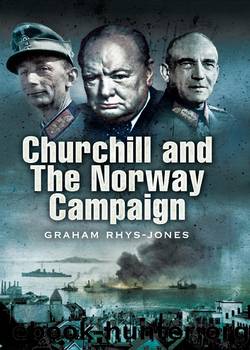Churchill and the Norway Campaign, 1940 by Graham Rhys-Jones

Author:Graham Rhys-Jones [Rhys-Jones, Graham]
Language: eng
Format: epub
Tags: History, Military, World War II, Europe, Great Britain, General
ISBN: 9781844689293
Google: _gXMDwAAQBAJ
Publisher: Casemate Publishers
Published: 2008-10-30T00:28:18+00:00
Chapter 9
Painful Decisions and a Parliamentary Occasion
The Chiefs of Staff met to consider Churchill's call for the revival of âHammerâ during the evening of 25 April. It was a âdamnableâ meeting according to Ironside at which Churchill tried (quite improperly) to push the Chiefs towards an affirmative answer. With the southern front in disarray and disturbing news of German progress in the Ãsterdal, a coup de main against Trondheim had seemed the only alternative to a humiliating retreat, but the arguments that had turned staff opinion against âHammerâ six days earlier remained as valid as ever. In their report to the MCC the Chiefs of Staff advised that the operation would take ten days to mount and that it would be impossible to make Trondheim safe against the scale of air attack that the Germans would bring against it. Once these propositions were accepted, the way ahead became clear. Troop withdrawals from France could be stopped, central Norway could be evacuated, and the capture of Narvik (the primary object all along) could be pursued âwith all the speed and energy possibleâ. The Prime Minister (still chairing the MCC) was worried about the effect of withdrawal on neutral opinion and on the Government's standing at home, and had wanted to present the evacuation as part of a deliberate plan to concentrate effort in the far north. It was agreed that no date would be set for the operation and that evacuation would be postponed as long as possible â preferably until after the capture of Narvik.1
Cabinet members were uneasy when presented with these proposals but Chamberlain had taken care in recent days to keep his colleagues abreast of the situation and criticism was muted. Anthony Eden, Secretary of State for the Colonies, wanted to hold Namsos as an âoutpost for Narvikâ and Sir John Simon, the Chancellor, argued that the abandonment of central Norway was inconsistent with undertakings given at the SWC only four days previously. There was logic in his arguments for the French were furious at this new example of British backsliding. Alerted (by Ironside) that big decisions were in the offing, General Maurice Gamelin (the French military Supremo) flew to London at the behest of the Comité de Guerre to argue the case that Trondheim should be taken âcoûte que coûteâ. That evening (26 April) he attended a special session of the War Cabinet. Churchill explained the Government's dilemma, stressing in particular the effects of German air action and the strain on naval resources. The situation, he said, had profoundly altered since the meeting of the SWC and was now âvery graveâ. HMG had reviewed the case for a direct attack on Trondheim but had rejected the idea after very careful consideration. Plans for Narvik remained unaffected and this had always been the âprimary strategic objectiveâ. In reply, Gamelin argued the case for maintaining a bridgehead in the mountains near à ndalsnes (a job tailor-made for his Alpine troops) and pointed out that the defence of Narvik began in central Norway.
Download
This site does not store any files on its server. We only index and link to content provided by other sites. Please contact the content providers to delete copyright contents if any and email us, we'll remove relevant links or contents immediately.
Room 212 by Kate Stewart(5040)
The Crown by Robert Lacey(4729)
Endurance: Shackleton's Incredible Voyage by Alfred Lansing(4683)
The Iron Duke by The Iron Duke(4293)
The Rape of Nanking by Iris Chang(4139)
Joan of Arc by Mary Gordon(4016)
Killing England by Bill O'Reilly(3953)
Say Nothing by Patrick Radden Keefe(3903)
I'll Give You the Sun by Jandy Nelson(3359)
Shadow of Night by Deborah Harkness(3307)
Hitler's Monsters by Eric Kurlander(3269)
Mary, Queen of Scots, and the Murder of Lord Darnley by Alison Weir(3152)
Blood and Sand by Alex Von Tunzelmann(3140)
Darkest Hour by Anthony McCarten(3072)
Eleanor & Park by Rainbow Rowell(3063)
Margaret Thatcher: The Autobiography by Thatcher Margaret(3029)
Red Famine: Stalin's War on Ukraine by Anne Applebaum(2874)
Book of Life by Deborah Harkness(2869)
The One Memory of Flora Banks by Emily Barr(2803)
